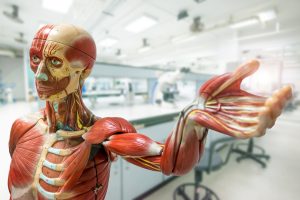How Long is an MRI Technician Program?
Published - March 20, 2024

What is a Magnetic Resonance Imaging (MRI) Machine?
Magnetic Resonance Imaging (MRI) is a non-invasive imaging machine that uses magnets and radio waves to create three-dimensional cross-sectional images of internal body structures based on the cellular response to hydrogen. MRIs are preferred to obtain deep, high-resolution brain, spine, and joint images.
To create MRI images, a patient lies inside a large magnet and must remain still during imaging. Gadolinium, a contrast agent, may be given to the patient to speed up the process.
What are MRI Machines Used For?
MRI machines are suitable for imaging non-bony parts of the body like the brain, spinal cord, nerves, muscles, ligaments, and tendons. An MRI machine is used to detect diseases and diagnose and monitor treatments. An MRI can differentiate between white and grey matter to diagnose tumors. It can also observe brain structures and understand how the brain works.
How Long is an MRI Technician Program?
Did you know you can become an MRI Tech in as little as 18 months? The AAS in MRI Technologist Program follows the ARRT Primary Pathway and prepares you with the knowledge and skills needed to succeed as a Magnetic Resonance Imaging Technologist.
CBD College offers small class sizes so you can get personalized instruction where no one is left behind. You will be able to network with instructors and classmates for years to come. This can come in handy when it is time to start a new job. CBD College also offers career services to help you find a job after graduation. We have strong ties in the community with medical facilities that are happy to hire graduates from CBD College.
What Do You Learn During an MRI Technician Program?
Many general and MRI-specific courses will prepare you for a career as an MRI technologist. These courses include:
General Studies
Students will review college math, communication skills, and physics to prepare for core MRI technician courses.
College Math – the fundamentals of arithmetic for those with minimal algebra experience.
Written & Oral Communication Skills – a course to develop communication skills for collaboration in a healthcare team. This course emphasizes written, verbal, and non-verbal communication, styles, and methods appropriate for different audiences.
Physics – an introduction to physics basic concepts and principles of the law of physics, including mechanics, thermodynamics, heat, fluids, sound, waves and vibrations, electricity, magnetism, and optics.
Human Anatomy & Physiology
A course on the principles of human anatomy, including body systems, organs, tissues, and cells. Topics include the nature of science, human genetics, and development.
Medical Terminology
A course on the basic word structure, anatomical terms, and the terminology for organ systems, body structures, medical diagnoses, and procedures.
MRI Safety and Patient Care
An introduction to MRI clinical practices and concepts of HIPAA, OSHA, vital signs, monitoring patients, emergency response, communication, charting, and coding.
HIPAA – a review of the Health Insurance Portability and Accountability Act of 1996, a federal law requiring medical professionals to adhere to national standards that help protect sensitive patient health information.
OSHA – Occupational Safety and Health Administration ensures safety and healthy working conditions for medical professionals by setting and enforcing standards in training and education.
Vital Signs – includes monitoring and recording temperature, respiratory rate, heart rate, blood pressure, height, and weight.
Intro to Clinical MRI
A course on how to enter, act, and interact with clinical diagnostic MRI imaging environments.
Sequence Parameters, Options, Data Acquisition and Processing
A comprehensive overview of magnetic resonance imaging parameters, imaging options, pulse sequences, data manipulation, image formation, and contrast.
Cross Sectional Anatomy, Pathology, and Imaging Procedures
An introduction to human anatomy and physiology and related pathologies. This includes bones, tendons, muscles, nerves, vascular structures, organs, and soft tissues.
Physical Principles of Image Formation
A comprehensive overview of magnetic resonance imaging principles. Topics include MRI history, tissue characteristics, pulse sequencing, imaging parameters and options, and image formation.
How do You Become an MRI Tech?
A great way to become an MRI tech is to complete the MRI Technologist program at CBD College. If you like the idea of working side-by-side with physicians and radiologists and enjoy a good challenge in a technologically advanced field, MRI Tech is your career choice!
A graduate of the MRI program is qualified to work as an entry-level MRI technologist in a hospital, medical center, clinic, radiology imaging center, or physician’s office. This program also prepares graduates for the American Registry of Radiologic Technologies (ARRT) MRI Primary Pathway credentialing exam.
MRI Technician Program
If you enjoy working side-by-side with physicians and radiologists and enjoy a good challenge in a technologically advanced field, this is your career choice!
In as little as 18 months, the AAS in MRI Program that follows the ARRT Primary Pathway will prepare you with the knowledge and skills you will need to fulfill the responsibilities of a Magnetic Resonance Imaging Technologist.
Contact us now to learn more.




